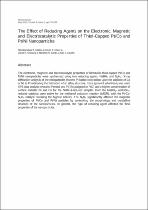 ResearchSpace
ResearchSpace
The effect of reducing agents on the electronic, magnetic and electrocatalytic properties of thiol-capped Pt/Co and Pt/Ni nanoparticles
JavaScript is disabled for your browser. Some features of this site may not work without it.
- ResearchSpace
- →
- Research Publications/Outputs
- →
- Journal Articles
- →
- View Item
| dc.contributor.author |
Mathe, Ntombizodwa R

|
|
| dc.contributor.author |
Nkosi, SS

|
|
| dc.contributor.author |
Motaung, DE

|
|
| dc.contributor.author |
Scriba, Manfred R

|
|
| dc.contributor.author |
Coville, NJ

|
|
| dc.date.accessioned | 2015-08-17T13:30:49Z | |
| dc.date.available | 2015-08-17T13:30:49Z | |
| dc.date.issued | 2015-05 | |
| dc.identifier.citation | Mathe, NR, Nkosi, S.S, Motaung, D.E, Scriba, M.R and Coville, N.J. 2015. The effect of reducing agents on the electronic, magnetic and electrocatalytic properties of thiol-capped Pt/Co and Pt/Ni nanoparticles. Electrocatalysis, vol. 6(3), pp 274-285 | en_US |
| dc.identifier.issn | 1868-2529 | |
| dc.identifier.uri | http://link.springer.com/article/10.1007%2Fs12678-014-0241-y | |
| dc.identifier.uri | http://hdl.handle.net/10204/8015 | |
| dc.description | Copyright: 2015 Springer. Due to copyright restrictions, the attached PDF file only contains the abstract of the full text item. For access to the full text item, please consult the publisher's website. The definitive version of the work is published in Electrocatalysis, vol. 6(3), pp 274-285 | en_US |
| dc.description.abstract | The electronic, magnetic and electrocatalytic properties of bimetallic thiol-capped Pt/Co and Pt/Ni nanoparticles were synthesised using two reducing agents, NaBH(sub4) and N(sub2)H(sub4). X-ray diffraction analysis of the nanoparticles showed Pt lattice contraction upon the addition of Co or Ni to Pt indicating the formation of an alloy structure, more apparent when N(sub2)H(sub4) was used. XPS data analysis revealed Pt metal and Pt(II) (assigned to PtO) and a higher concentration of surface metallic Ni and Co for the NaBH(sub4-)reduced samples. Both the NaBH(sub4-) and N2H(sub4-)reduced catalysts were active for the methanol oxidation reaction (MOR), with the Pt-Co-N(sub2)H(sub4) catalyst revealing the highest activity. The N(sub2(H(sub4) significantly affected the magnetic properties of Pt/Co and Pt/Ni particles by controlling the morphology and crystalline structure of the nanoparticles. In general, the type of reducing agent affected the final properties of the nanoparticles. | en_US |
| dc.language.iso | en | en_US |
| dc.publisher | Springer | en_US |
| dc.relation.ispartofseries | Workflow;15028 | |
| dc.subject | Nanoparticles | en_US |
| dc.subject | Physical chemistry | en_US |
| dc.subject | Electrochemistry | en_US |
| dc.title | The effect of reducing agents on the electronic, magnetic and electrocatalytic properties of thiol-capped Pt/Co and Pt/Ni nanoparticles | en_US |
| dc.type | Article | en_US |
| dc.identifier.apacitation | Mathe, N. R., Nkosi, S., Motaung, D., Scriba, M. R., & Coville, N. (2015). The effect of reducing agents on the electronic, magnetic and electrocatalytic properties of thiol-capped Pt/Co and Pt/Ni nanoparticles. http://hdl.handle.net/10204/8015 | en_ZA |
| dc.identifier.chicagocitation | Mathe, Ntombizodwa R, SS Nkosi, DE Motaung, Manfred R Scriba, and NJ Coville "The effect of reducing agents on the electronic, magnetic and electrocatalytic properties of thiol-capped Pt/Co and Pt/Ni nanoparticles." (2015) http://hdl.handle.net/10204/8015 | en_ZA |
| dc.identifier.vancouvercitation | Mathe NR, Nkosi S, Motaung D, Scriba MR, Coville N. The effect of reducing agents on the electronic, magnetic and electrocatalytic properties of thiol-capped Pt/Co and Pt/Ni nanoparticles. 2015; http://hdl.handle.net/10204/8015. | en_ZA |
| dc.identifier.ris | TY - Article AU - Mathe, Ntombizodwa R AU - Nkosi, SS AU - Motaung, DE AU - Scriba, Manfred R AU - Coville, NJ AB - The electronic, magnetic and electrocatalytic properties of bimetallic thiol-capped Pt/Co and Pt/Ni nanoparticles were synthesised using two reducing agents, NaBH(sub4) and N(sub2)H(sub4). X-ray diffraction analysis of the nanoparticles showed Pt lattice contraction upon the addition of Co or Ni to Pt indicating the formation of an alloy structure, more apparent when N(sub2)H(sub4) was used. XPS data analysis revealed Pt metal and Pt(II) (assigned to PtO) and a higher concentration of surface metallic Ni and Co for the NaBH(sub4-)reduced samples. Both the NaBH(sub4-) and N2H(sub4-)reduced catalysts were active for the methanol oxidation reaction (MOR), with the Pt-Co-N(sub2)H(sub4) catalyst revealing the highest activity. The N(sub2(H(sub4) significantly affected the magnetic properties of Pt/Co and Pt/Ni particles by controlling the morphology and crystalline structure of the nanoparticles. In general, the type of reducing agent affected the final properties of the nanoparticles. DA - 2015-05 DB - ResearchSpace DP - CSIR KW - Nanoparticles KW - Physical chemistry KW - Electrochemistry LK - https://researchspace.csir.co.za PY - 2015 SM - 1868-2529 T1 - The effect of reducing agents on the electronic, magnetic and electrocatalytic properties of thiol-capped Pt/Co and Pt/Ni nanoparticles TI - The effect of reducing agents on the electronic, magnetic and electrocatalytic properties of thiol-capped Pt/Co and Pt/Ni nanoparticles UR - http://hdl.handle.net/10204/8015 ER - | en_ZA |





